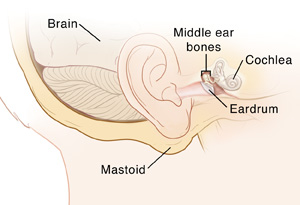Mastoidectomy and Meatoplasty
Mastoidectomy and Meatoplasty

Mastoidectomy and meatoplasty are types of ear surgery. Mastoidectomy removes part of the mastoid bone (the bone behind the earlobe). It may be done if tiny air cells in the bone become infected or damaged. These problems can increase the risk of ear infections and hearing loss. Meatoplasty makes the opening into the ear canal (meatus) larger. A meatoplasty may be done with mastoidectomy in a two-part procedure.
Preparing for surgery
Prepare for the procedure as you have been instructed. Be sure to tell your healthcare provider about all medicines you take. This includes over-the-counter medicines. It also includes herbs and other supplements. You may need to stop taking some or all of them before surgery. Your healthcare provider will discuss this with you. Also, follow any directions you’re given for not eating or drinking before surgery.
The day of surgery
The surgery takes about 1 to 3 hours. You’ll likely go home on the same day or you may stay over night. Before the surgery begins:
-
An IV line is put into a vein in your arm or hand. This line supplies fluids and medicines.
-
To keep you free of pain, you’re given general anesthesia. This medicine puts you into a state like deep sleep through the surgery.
During mastoidectomy
Here is what to expect during the surgery:
-
An incision is made behind or near the ear, depending on the type of procedure.
-
The mastoid bone is exposed.
-
The diseased or damaged air cells in the mastoid bone are removed.
-
The bony wall between the ear canal and mastoid bone may also be removed.
During meatoplasty
Incisions are made in and around the ear canal. Then tissue is removed or rearranged to make the ear opening larger.
When both procedures are finished
The ear canal will be filled with antibiotic ointment or fluid. This helps prevent infection. Packing (a special kind of dressing) may also be placed in the ear canal. Any incisions made are closed with stitches. A sterile bandage may then be placed over the ear.
After the surgery
You’ll be taken to a room to wake up from the anesthesia. You’ll be given medicines to manage pain and prevent infection. If you have packing inside the ear canal, you may have trouble hearing out of that ear. This is not a sign of a problem. Be aware that you may have some dizziness after the surgery. This can last for a few days. When it’s time for you to be released from the hospital, have an adult family member or friend ready to drive you.
Recovering at home
Once at home, follow any special instructions you are given. Make sure to:
-
Take all medicines as directed. These may include ear drops and ear ointment.
-
Care for your incision and packing as instructed.
-
Make sure you know what you are allowed to do as far as daily activities. Ask about exercise, driving, and travel.
When to call your healthcare provider
Be sure you have a contact number for your healthcare provider. After you get home, call if you have:
-
Chest pain or trouble breathing (call 911)
-
Fever of 100.4°F (38°C) or higher, or as directed by your healthcare provider
-
Bright red bleeding or foul-smelling drainage from your ear (some pink-tinged drainage is normal)
-
Increased redness or swelling around the ear
-
Severe headache and stiff neck
-
Facial weakness
-
Dizziness, nausea, or vomiting that gets worse
-
Pain that cannot be controlled with medicines
Follow-up
During follow-up visits, your healthcare provider will check your healing. If your stitches or packing need to be removed, this may be done in about 7 to 10 days. You and your healthcare provider can also discuss any more treatments or surgeries that may be needed. Going forward, you’ll need regular visits with your healthcare provider to have your ear checked and cleaned.
Risks and possible complications
Risks of these procedures include:
-
Change in the shape of the ear
-
Bleeding
-
Ringing in the ear (tinnitus)
-
Change in sense of taste
-
Infection
-
Spinning sensation (vertigo)
-
Leakage of cerebrospinal fluid (liquid around brain and spinal cord)
-
Hearing loss, which may be permanent
-
Facial weakness or paralysis
-
Need for more surgery
-
Risks of anesthesia
Updated:
March 16, 2019
Sources:
Chronic otitis media, cholesteatoma, and mastoiditis in adults. UpToDate, Mastoid Surgery. ENT UK Royal College of Surgeons of England
Reviewed By:
Holloway, Beth Greenblatt, RN, M.Ed.,Kacker, Ashutosh, MD